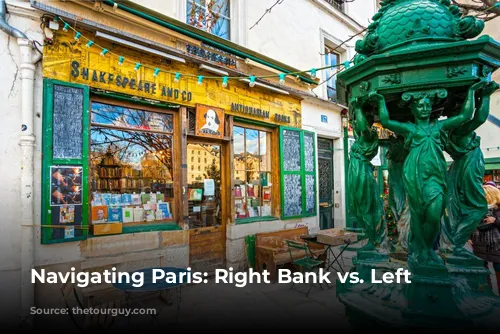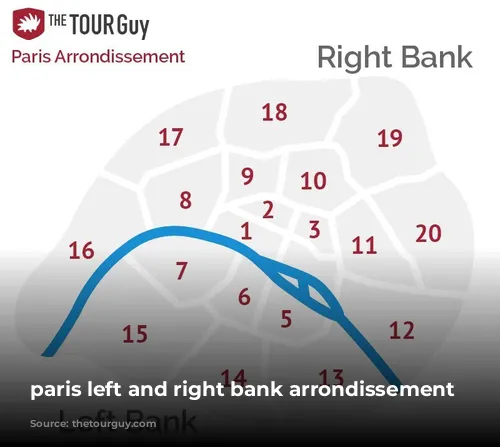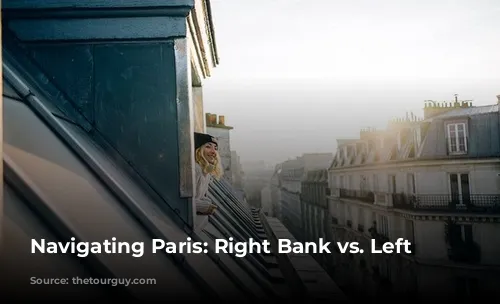Ever heard someone say, “Meet me in the 4th” or “I’m staying on the left bank, the right bank is too fancy for me?” It can be confusing, especially if you’re new to Paris. This article will break down the differences between the right and left banks and explain what an arrondissement is, so you can navigate the City of Lights like a local!
Understanding the Seine: Left Bank and Right Bank
The Seine river splits Paris into two halves: the right bank (Rive Droite) and the left bank (Rive Gauche). Think of it like this: When you face West (towards the ocean), the right side of the Seine is the right bank, and the left side is the left bank.
But what about the arrondissements? Paris is divided into 20 arrondissements, or districts, that spiral out in a clockwise direction from the center. The first arrondissement, where you’ll find the Louvre and the Tuileries Gardens, is the smallest, and they get bigger as you move outward.
What is an Arrondissement?
The arrondissement system was established in 1795, initially dividing Paris into 12 arrondissements. The first nine were on the right bank, and the remaining three were on the left bank.
In the mid-19th century, under Napoleon III, Paris underwent significant expansion, adding eight more arrondissements. This expansion solidified the 20 arrondissements that exist today.
A fun historical tidbit: The residents of the Passy neighborhood, initially part of the first arrondissement, were furious when the new layout placed them in the 13th. They believed the 13th was associated with unmarried couples living together, a stigma they didn’t want to be associated with. So, they successfully lobbied to have their neighborhood reassigned to the 16th arrondissement.
Locals often shorten “arrondissement” to “the 5th” or “the 16th,” so you don’t have to say the whole word. You can also see it written as “arr.” in literature. So, if you’re staying in the Latin Quarter (the 5th arrondissement) and someone asks where you are, simply say, “the 5th.”

Historical Differences: Right Bank vs. Left Bank
Historically, the right bank was the commercial hub of Paris, populated by the wealthy elite and bustling with industry. It houses some of the city’s most famous museums, like the Louvre, the Musée d’Art Moderne, and the Musée de l’Orangerie.
The left bank, on the other hand, had a bohemian vibe. It was home to la Sorbonne and other universities, attracting students and artists who sought affordable housing. The Latin Quarter (5th and 6th arr.) became a haven for artistic expression, frequented by literary giants like Picasso, James Joyce, and Hemingway.
The right bank’s wealth was undeniable, but eventually, the allure of the left bank’s artistic spirit drew many across the Seine. The Saint Germain des Prés neighborhood became a popular spot for right-bankers to visit Café des Deux Magots, a favored haunt of the left-bank literary crowd.
The Evolution of Paris: Today’s Right Bank and Left Bank
Today, the distinction between right bank and left bank is less pronounced. Both sides have become extremely expensive, and the traditional “bohemian” vs. “capitalist” stereotype has largely faded.
However, the 5th and 6th arrondissements still hold a strong student and artistic presence. Meanwhile, le Marais, on the right bank, has emerged as Paris’s most trendy and artistic neighborhood.

Where to Stay in Paris: Finding Your Perfect Spot
No matter where you choose to stay, Paris is a city best explored on foot. But, if you’re looking for a central location, the vicinity of Notre Dame offers easy access to bars, restaurants, and metro connections.
Ready to experience the magic of Paris? Our Paris tours provide unique experiences for every type of traveler.
Conclusion
Understanding the differences between Paris’ right and left banks can help you navigate the city like a local. From the historical significance of the arrondissements to the vibrant cultural tapestry of each side of the Seine, Paris offers a fascinating journey for every traveler. Whether you choose the sophisticated charm of the right bank or the bohemian spirit of the left bank, Paris is a city that will leave you with memories to cherish forever.




